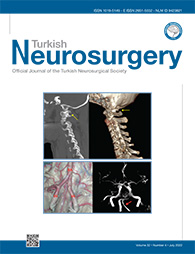2Dicle University Faculty of Medicine, Department of Neurosurgery, Diyarbakir, Turkey
3Amasya University Faculty of Medicine, Department of Neurosurgery, Amasya, Turkey
4Hacettepe University Faculty of Medicine, Department of Histology and Embryology, Ankara, Turkey
5Hacettepe University Faculty of Medicine, Department of Radiology, Ankara, Turkey
6TOBB-ETU Hospital, Department of Radiology, Ankara, Turkey DOI : 10.5137/1019-5149.JTN.36863-21.1 AIM: To validate a new particulate embolization method using degradable starch microspheres (DSM) and intraarterial exogenous amylase administration, which allow for regulated temporary cerebral arterial embolization without compromising tissue perfusion.
MATERIAL and METHODS: Twenty-four male New Zealand rabbits were randomly divided into three groups. All animals underwent routine angiography. The control group received no additional intervention. In the ischemia group, 0.2ml DSM was administered to the animals via the right carotid artery with pulsed, gentle injections to induce ischemia in the cerebral microcirculation. Animals in the reperfusion group received 0.05 ml of exogenous amylase along with DSM administration. Six hours after the procedure, the animals were sacrificed and histopathological analysis was performed.
RESULTS: The ischemia group was the most adversely affected group by embolization, with the highest number of pyknotic neurons. The reperfusion group, which received exogenous amylase, had lower pyknotic neurons than the ischemia group. The pyknotic neuron count was similar in some regions between reperfusion and control groups.
CONCLUSION: Exogenous amylase can rapidly attenuate cerebral ischemia caused by microembolization with DSM.
Keywords : Exogenous amylase, Cerebral ischemia, Degradable starch microsphere, Angiography, Rabbit model




